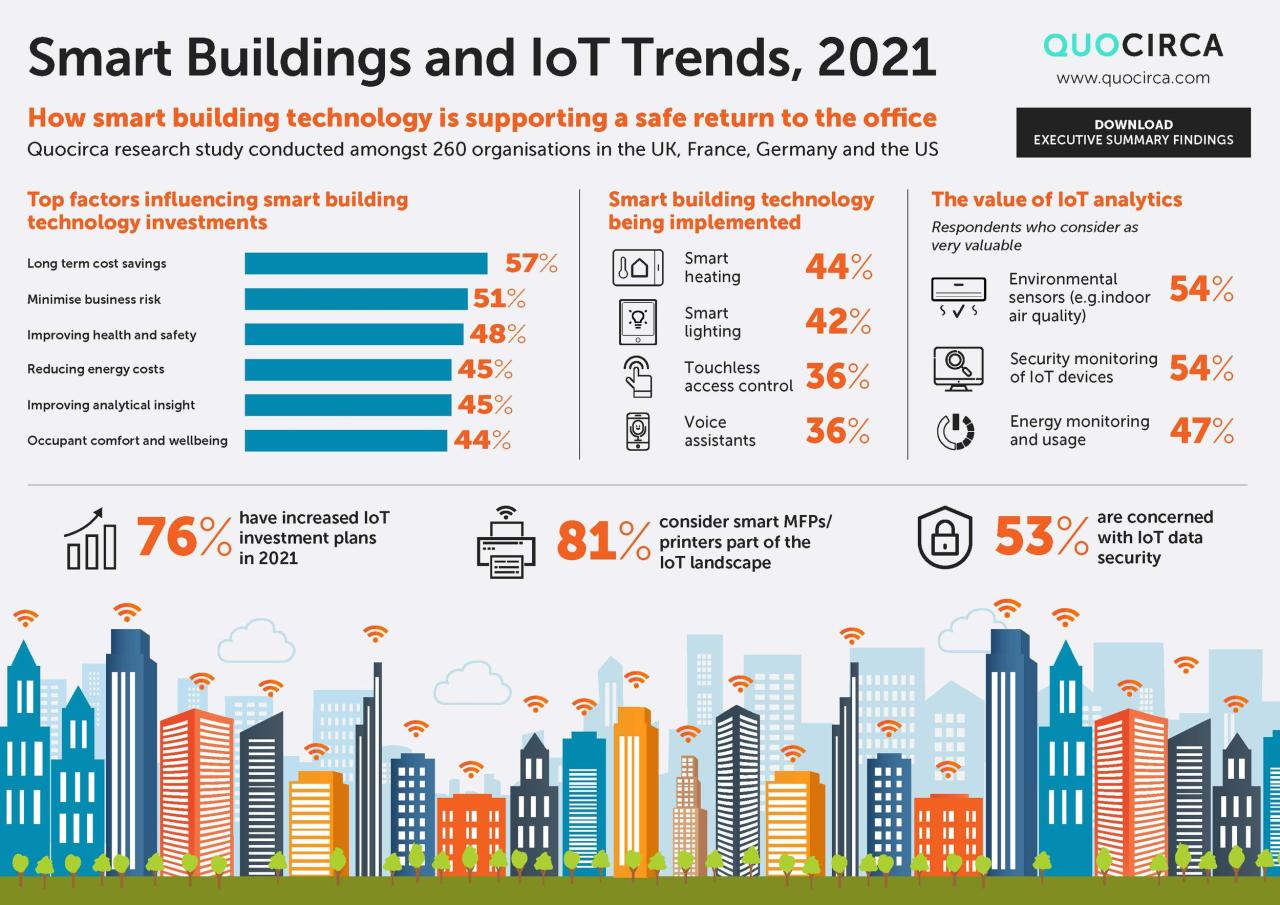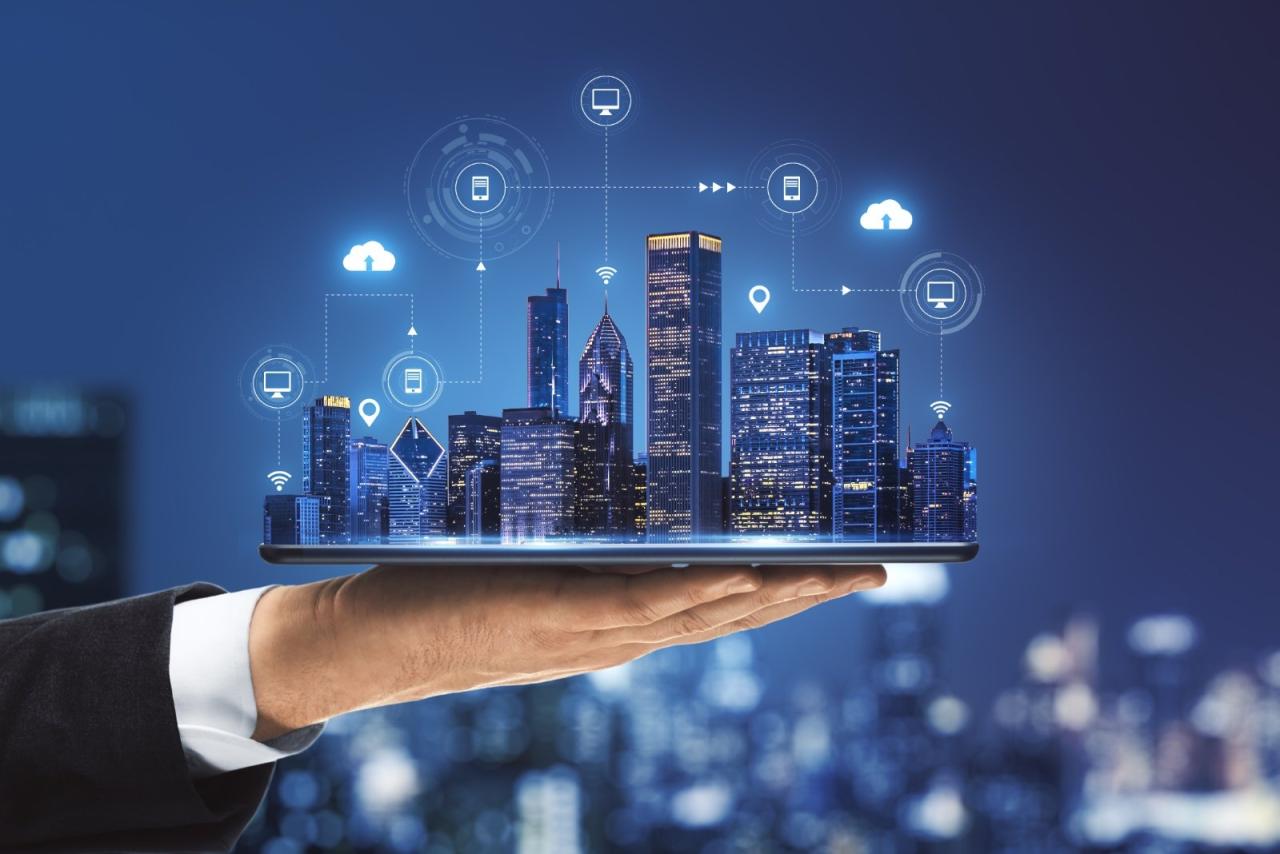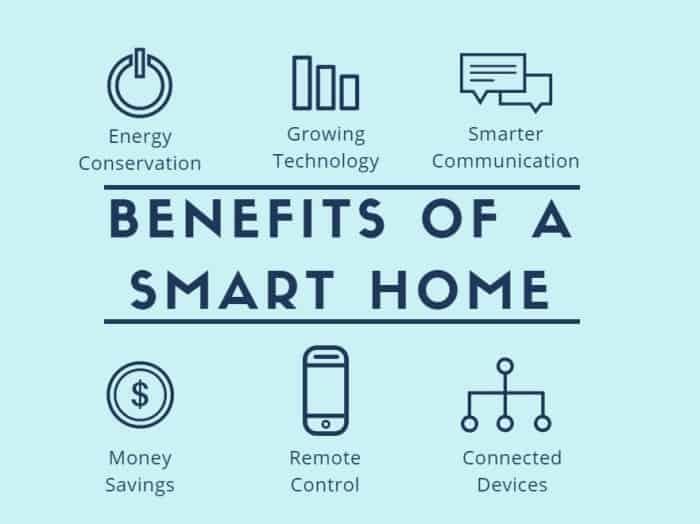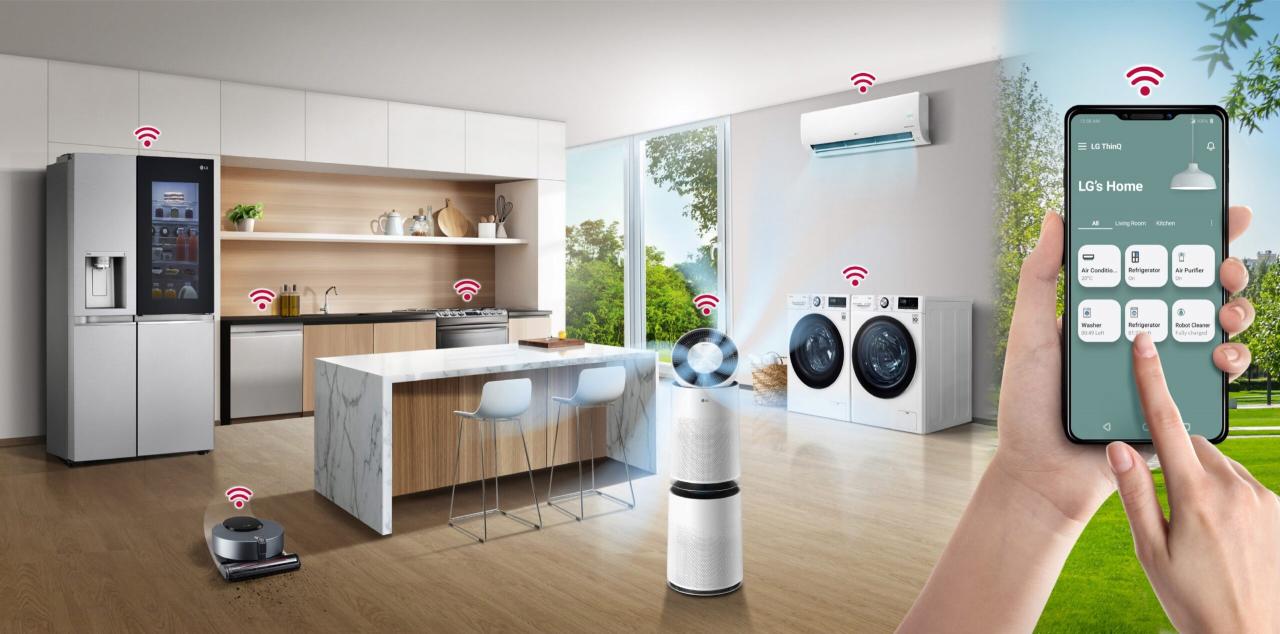Starting with smart buildings trends, this topic delves into the latest technologies, sustainability practices, security measures, user experience, and system integration. Embracing innovation, smart buildings are revolutionizing the way we interact with our environment.
Current Trends in Smart Buildings
Smart buildings are continuously evolving with the integration of cutting-edge technologies to enhance efficiency, sustainability, and user experience. Let’s delve into the latest trends shaping the landscape of smart buildings.
Integration of Latest Technologies
Smart buildings are incorporating a wide range of technologies to streamline operations and improve overall functionality. From IoT sensors to cloud computing and advanced analytics, these technologies are revolutionizing the way buildings are managed. For instance, IoT devices enable real-time monitoring of energy consumption, lighting, and HVAC systems, allowing for precise adjustments to optimize efficiency and reduce costs.
IoT Transforming Building Management
The Internet of Things (IoT) plays a pivotal role in transforming building management by connecting various devices and systems to a centralized platform. This interconnected network enables seamless communication between different components, such as sensors, actuators, and control systems. By leveraging IoT, building managers can remotely monitor and control building operations, detect maintenance issues proactively, and make data-driven decisions to enhance occupant comfort and productivity.
Role of Artificial Intelligence
Artificial intelligence (AI) is increasingly being employed to optimize smart building operations through predictive maintenance, energy management, and occupant behavior analysis. AI algorithms can analyze vast amounts of data collected from sensors and devices to identify patterns, predict equipment failures, and automate decision-making processes. By harnessing the power of AI, smart buildings can achieve higher energy efficiency, reduce operational costs, and provide personalized experiences for occupants.
Sustainable Practices in Smart Buildings

Smart buildings are at the forefront of sustainable practices in the construction industry, incorporating various energy-efficient features to reduce their environmental impact and carbon footprint. By leveraging technology and automation, these buildings not only enhance comfort and productivity for occupants but also contribute significantly to a more sustainable future.
Energy-Efficient Features in Smart Buildings
Smart buildings are equipped with a range of energy-efficient features that set them apart from traditional buildings. These include:
- Smart lighting systems that adjust brightness based on natural light levels and occupancy, reducing energy consumption.
- Automated HVAC systems that optimize temperature control and ventilation, leading to energy savings.
- Solar panels and renewable energy sources integrated into the building design to generate clean electricity on-site.
- Advanced building automation systems that monitor and control energy usage in real-time, identifying opportunities for optimization.
Comparison with Traditional Buildings
When compared to traditional buildings, smart buildings demonstrate a clear advantage in sustainability. Traditional buildings often rely on manual adjustments for lighting, heating, and cooling, resulting in energy wastage. In contrast, smart buildings utilize data analytics and IoT technology to operate efficiently, minimizing energy consumption and reducing costs in the long run.
Contribution to Reducing Carbon Footprint
By incorporating energy-efficient features and sustainable practices, smart buildings play a crucial role in reducing carbon footprint. The optimized energy usage, renewable energy sources, and smart systems lead to lower greenhouse gas emissions and overall environmental impact. With the implementation of sustainable practices, smart buildings pave the way for a greener and more eco-friendly future.
Security Measures in Smart Buildings: Smart Buildings Trends
Smart buildings are equipped with advanced technologies that improve efficiency and convenience, but they also face cybersecurity challenges that need to be addressed. Implementing robust security measures is crucial to protect these buildings from potential threats and ensure the safety of occupants and sensitive data.
Cybersecurity Challenges Faced by Smart Buildings
- Smart buildings are vulnerable to cyber attacks due to interconnected devices and systems.
- Hackers can exploit security loopholes to gain unauthorized access to building controls and sensitive information.
- Ransomware attacks can disrupt building operations and compromise safety measures.
- Phishing scams and social engineering tactics can trick users into revealing confidential information.
Advanced Security Systems Used to Protect Smart Buildings, Smart buildings trends
- Biometric authentication: Implementing fingerprint or facial recognition systems for secure access control.
- Firewall protection: Installing firewalls to monitor and filter network traffic to prevent unauthorized access.
- Intrusion detection systems: Using sensors and alarms to detect and alert against potential security breaches.
- Security cameras and surveillance: Monitoring building premises for suspicious activities and unauthorized access.
Importance of Data Encryption in Securing Smart Building Networks
Data encryption plays a crucial role in safeguarding smart building networks from cyber threats. By encrypting data transmissions and storage, sensitive information is scrambled into unreadable formats, making it difficult for hackers to intercept and misuse. Encryption ensures that only authorized users can access and decipher the data, enhancing overall security and privacy in smart buildings.
User Experience and Comfort
Smart buildings are revolutionizing the way occupants interact with their environment, focusing on enhancing user experience and comfort. By integrating cutting-edge technologies, these buildings are designed to prioritize occupant well-being and satisfaction.
Personalized Climate Control
- Smart buildings offer customizable features such as personalized climate control, allowing occupants to adjust temperature and airflow according to their preferences.
- Through smart sensors and AI-powered systems, buildings can automatically adjust settings based on occupancy patterns, ensuring a comfortable environment at all times.
Natural Lighting Optimization
- Utilizing smart lighting systems, buildings can optimize natural light exposure to create a more pleasant and productive indoor environment.
- Automated blinds and sensors can adjust light levels throughout the day, reducing energy consumption while enhancing occupant comfort.
Enhanced Security Features
- Smart buildings integrate advanced security measures such as facial recognition technology and access control systems to ensure occupant safety and peace of mind.
- Real-time monitoring and alerts provide a sense of security, allowing occupants to focus on their tasks without worrying about safety concerns.
Integration of Smart Building Systems

In a smart building, the integration of various systems is crucial for maximizing efficiency and ensuring seamless operations. Interoperability among different smart building systems allows them to communicate and work together harmoniously, creating a cohesive and interconnected environment.
Challenges of Integrating Diverse Technologies
Integrating diverse technologies in a smart building poses several challenges, such as compatibility issues, data security concerns, and complex installation processes. Ensuring that different systems can effectively communicate and share data is essential for achieving a truly integrated smart building ecosystem.
Benefits of a Well-Integrated Smart Building System
– Improved efficiency: Integration of systems leads to streamlined operations and automation, reducing energy consumption and operational costs.
– Enhanced user experience: A well-integrated system can provide personalized settings for occupants, optimizing comfort and productivity.
– Increased security: Integrated systems can work together to enhance security measures, such as access control and surveillance, improving overall safety within the building.
– Data-driven insights: By integrating various systems, smart buildings can collect and analyze data more effectively, providing valuable insights for decision-making and optimization.
Question & Answer Hub
How are smart buildings contributing to reducing carbon footprint?
Smart buildings incorporate energy-efficient features and advanced systems that help in reducing energy consumption, thereby lowering the carbon footprint.
What is the role of data encryption in securing smart building networks?
Data encryption plays a crucial role in safeguarding sensitive information transmitted across smart building networks, ensuring data privacy and security.
How do smart buildings enhance user experience?
Smart buildings offer customizable features that improve comfort and well-being, creating a more personalized and enjoyable environment for occupants.





